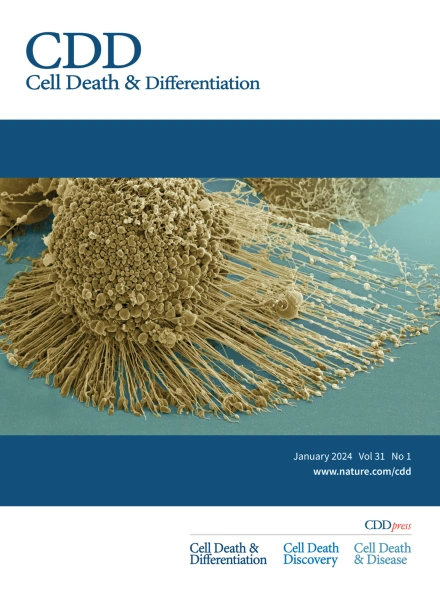外stosin糖基转移酶2 (EXT2)在胶质母细胞瘤细胞代谢、放射敏感性和铁凋亡中的新作用
IF 15.4
1区 生物学
Q1 BIOCHEMISTRY & MOLECULAR BIOLOGY
引用次数: 0
摘要
胶质母细胞瘤(GBM)采用各种策略抵抗治疗,导致患者生存率低。其生存机制的一个关键方面在于代谢调节,维持快速生长和逃避细胞死亡。最近的研究揭示了治疗抵抗与铁下垂之间的联系,铁下垂是一种由代谢功能障碍引发的脂质过氧化依赖的细胞死亡机制。我们的目的是鉴定GBM细胞治疗耐药的新调节因子。我们结合来自一组人类GBM细胞模型和TCGA GBM患者数据集的rna测序数据进行了全面分析。我们重点研究了与GBM患者生存率低相关的前12个差异表达候选基因,并进行了RNA干扰介导的筛选,以揭示这些分子的放射化学致敏潜力及其对代谢活性、DNA损伤、自噬和细胞凋亡的影响。我们确定了exostosin糖基转移酶2 (EXT2),一种在硫酸肝素生物合成中被描述的酶,是最有希望的候选者。在各种GBM细胞模型中,EXT2缺失引起细胞活力和增殖降低以及放化疗致敏。在机制上,我们通过进行非靶向和靶向代谢组学来探索EXT2的功能,并检测到EXT2缺失的GBM细胞表现出属于s -腺苷蛋氨酸(SAM)代谢的代谢物的丰度差异。考虑到这些代谢变化,我们测定了脂质过氧化,发现由转硫途径中代谢物水平下降导致的抗氧化能力下降导致铁下垂。此外,特异性SAM和转硫代谢相关酶的修饰表明,当EXT2耗尽时,它们具有促进生存和减少铁氧化的功能。总的来说,我们的研究结果揭示了EXT2在GBM细胞存活和对x射线辐射反应中的新作用,这是由铁凋亡调节控制的。这些发现扩大了我们对GBM细胞对放射(化疗)治疗的反应的理解,并可能有助于开发新的治疗方法。本文章由计算机程序翻译,如有差异,请以英文原文为准。


A novel role of exostosin glycosyltransferase 2 (EXT2) in glioblastoma cell metabolism, radiosensitivity and ferroptosis
Glioblastoma (GBM) employs various strategies to resist therapy, resulting in poor patient survival. A key aspect of its survival mechanisms lies in metabolic regulation, maintaining rapid growth and evading cell death. Recent studies revealed the connection between therapy resistance and ferroptosis, a lipid peroxidation-dependent cell death mechanism triggered by metabolic dysfunction. Our aim was to identify novel regulators of therapy resistance in GBM cells. We conducted a comprehensive analysis combining RNA-sequencing data from a panel of human GBM cell models and TCGA GBM patient datasets. We focused on the top-12 differentially expressed gene candidates associated with poor survival in GBM patients and performed an RNA interference-mediated screen to uncover the radiochemosensitizing potential of these molecules and their impact on metabolic activity, DNA damage, autophagy, and apoptosis. We identified exostosin glycosyltransferase 2 (EXT2), an enzyme previously described in heparan sulfate biosynthesis, as the most promising candidate. EXT2 depletion elicited reduced cell viability and proliferation as well as radiochemosensitization in various GBM cell models. Mechanistically, we explored EXT2 function by conducting untargeted and targeted metabolomics and detected that EXT2-depleted GBM cells exhibit a differential abundance of metabolites belonging to S-adenosylmethionine (SAM) metabolism. Considering these metabolic changes, we determined lipid peroxidation and found that the diminished antioxidant capacity resulting from decreased levels of metabolites in the transsulfuration pathway induces ferroptosis. Moreover, modifications of specific SAM and transsulfuration metabolism associated enzymes revealed a prosurvival and ferroptosis-reducing function when EXT2 is depleted. Collectively, our results uncover a novel role of EXT2 in GBM cell survival and response to X-ray radiation, which is controlled by modulation of ferroptosis. These findings expand our understanding of how GBM cells respond to radio(chemo)therapy and may contribute to the development of new therapeutic approaches.
求助全文
通过发布文献求助,成功后即可免费获取论文全文。
去求助
来源期刊

Cell Death and Differentiation
生物-生化与分子生物学
CiteScore
24.70
自引率
1.60%
发文量
181
审稿时长
3 months
期刊介绍:
Mission, vision and values of Cell Death & Differentiation:
To devote itself to scientific excellence in the field of cell biology, molecular biology, and biochemistry of cell death and disease.
To provide a unified forum for scientists and clinical researchers
It is committed to the rapid publication of high quality original papers relating to these subjects, together with topical, usually solicited, reviews, meeting reports, editorial correspondence and occasional commentaries on controversial and scientifically informative issues.
 求助内容:
求助内容: 应助结果提醒方式:
应助结果提醒方式:


